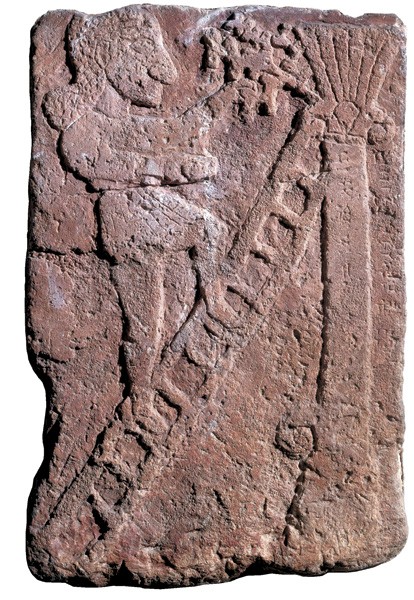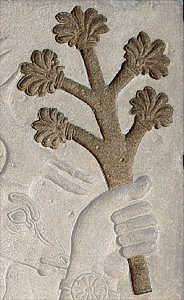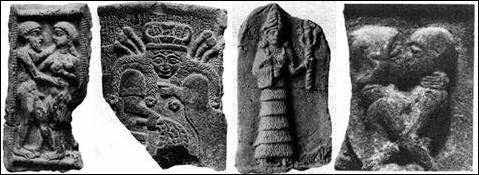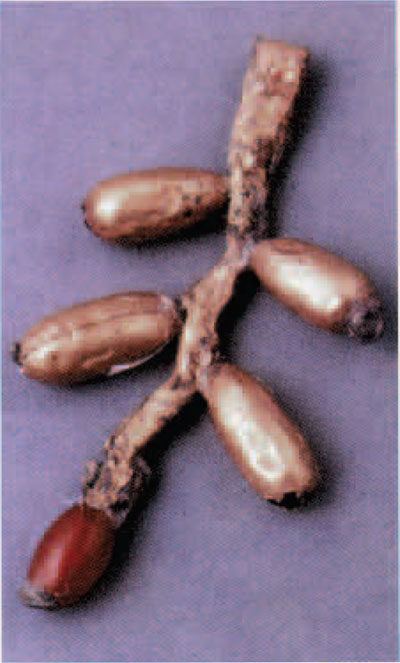
- Date palms were very much a part of the Mesopotamian landscape and everyday life. (Source)
The Coachella Valley in California is known for being the home of a certain music festival, but few people booking their first trip to that festival realize it is also home to countless date farms.
Dates are the oldest-cultivated fruit, but they only made it to California after 1898, when the US Department of Agriculture sent out some guys to collect exotic plants from around the world to bring back for cultivation in America, including mangoes, avocados and, you guessed it, dates.
Inspired by One Thousand and One Arabian Nights, a book that had enchanted many stateside with its stories of Aladdin and Sinbad, set against a landscape rich with date palms, the men charged with bringing back dates went straight to Baghdad, Iraq.

- Date palms in Coachella Valley, Calif. Dorothea Lange/Library of Congress, via NPR.
And so started the date’s journey from Mesopotamia to California. (Source)
Googling Dates
Sumerians first began their relationship with the date palm, a tree that towered up to 100 feet and could live up to 200 years, as early as 4000 BC, 5,000 years ago. Over time, they wound up with some 150 words to describe the different types of date palm and their different parts, a fact apparent in what Karen Rhea Nemet-Nejat refers to as the ancients’ “lexical texts,” in her book, Daily Life in Ancient Mesopotamia.
Nonetheless, they called the date palm (phoenix dactylifera) gishimmar, and its fruit, zulum.
Gishimmar and zulum might sound (and look) like perfectly Sumerian words to the untrained in Sumerian (me), but they are not. According to a German Assyriologist by the name of Benno Landsberger, these words are words from a pre-Sumerian language. This implies that the date palm and its fruit were a thing humans knew about before Sumerians became cultivators. Some sources I came across, including this resourceful HortScience paper from ChihCheng T. Chao and Robert Kreuger, place India alongside Mesopotamia as the origin of the idea to cultivate the date palm. Further, the Biblical Archaeology Society says in an article, “The earliest-known date seeds were found in Indus Valley settlements dating to the sixth millennium B.C., suggesting that dates originated in the East and were carried to the Near East and Egypt.”
This (Mesopotamia) Must Be the Place!
On the Natural History of the Date Palm Phoenix dactylifera page, Geoff Sanderson writes that the date palm needs “its feet in running water and its head in the fire of the sky.”
Such criteria made Lower Mesopotamia in the Tigris and Euphrates delta—where summers are dry, winters are mild, and irrigation was already a thing—the perfect location for the date palm to thrive and become a symbol of fecundity and success, as well as a vital part of the economy.
Even with the perfect conditions Lower Mesopotamia provided a date palm, however, it still took the plant four to six years from planting time to bear fruit, along with some 15 to 20 years to reach full productivity. To give some perspective, full productivity for a date palm is an annual output of about 45 pounds (20kg) of fruit per tree. For a plant that played such a vital economic role to so many people, it’s hard to imagine that such yields were enough to, one, support such thriving civilizations, and two, reach quintessence status.
Moreover, a natural palm grove features an even split of half female and half male trees. Such groves rely on Mother Nature to carry the males’ pollen to the females’ flowers via the wind or pollinating fauna. Needless to say, date palm yields were dependent upon which way the wind blew or how frisky a bee felt, something no bustling civilization could (or should, if it could help it) rely on.
Enter the quintessential Sumerian genius that increased yields and established a practice still in use today: artificial pollination.
We Should Date More!
To combat the uncertainty of nature, Sumerians took up artificial pollination. It sounds a lot more complicated than it was/is; all it took was grabbing a male plant, climbing up a female’s trunk and smearing the pollen from the male plant onto the female’s flowers. This not only ensured maximum yields regardless of Mother Nature’s whims, it also allowed for cultivators to have a lot more of the productive female trees per acre in their groves than male ones (a ratio of 49 females to one male).

- Artificial pollination in ancient Mesopotamia’s palm groves is not much different from artificial pollination in today’s palm groves, even in California. (Source)
To this day, the Sumerian way of ensuring high date-palm yields is in use, as described in this NPR piece, “Forbidding Fruit: How America Got Turned On To The Date”:
“And they still hand-pollinate dates today to ensure a reliable, successful crop. Francisco Paniagua was a palm worker, or palmero, for decades and is now a farmer with an orchard … During the spring pollinating season, he climbs up into the fronds of 50-foot female date palms. He works his way around the spiky branches of the crowns, spraying little puffs of yellow pollen gathered from the flowers of a male palm tree onto each flower of the female trees. (Source)”
The Importance of Being a Date Palm

- “The sacred tree in Assyrian mythology is a palm that symbolizes Ishtar connecting heaven, the crown of the tree, and earth, the base of the trunk.” (Source)
It is believed that the date palm may have represented fertility in humans in ancient Mesopotamia. (Source) This is a safe assumption to make, considering the symbolism of the sacred marriage ritual which took place each spring for the Sumerians and all those following them.
For the sacred marriage each spring, people gathered at the new year festival and watched the king’s procession from his palace to the city’s temple of Inanna (Ishtar), where he would meet up with the Mesopotamian goddess of fertility (represented by a high priestess) and be led into the temple to consummate the symbolic marriage of the god Dumuzi (Tammuz) and goddess of fertility. This is a symbolic effort to ensure that the coming year is a productive one.
According to the Pass the Flamingo blog:
“[Dumuzi’s] marriage to the goddess Inanna symbolized the annual date-harvest and storage; Inanna was the date-cellar, [Dumuzi] the fruit.”
Dumuzi’s association with the date palm extends to him being worshiped as Ama-ushumgal-anna, the power of the date-palm, by cities across Mesopotamia whose economies relied heavily on the date palm. Further, Inanna was considered “the one who makes the dates be full of abundance.” Both Dumuzi and Inanna are represented by date-palm paraphernalia; Dumuzi a date cluster or heart of palm, and Inanna a palm frond.

- Inanna depictions, including two implying the consummation of the sacred marriage between her and Dumuzi, a god of the underworld. (Source)
Dumuzi and Inanna weren’t the only gods associated with date palms and their fruit. Mylitta, the Babylonian moon goddess of love, beauty, fertility and childbirth, is also represented by the date palm.
And from the gods, the importance of the date palm only becomes more prominent through its presence in the most technical of texts that dealt with practical matters, the Code of Hammurabi. In an article I found on JSTOR about date culture, A.H. Pruessner writes about the extent of this importance:
“The rather large space devoted to the subject of date culture in the Code of Hammurabi testifies to the important position which it occupied in the agricultural life of his empire.”
And in their paper, “The Date Palm (Phoenix dactyliferaL.): Overview of Biology, Uses, and Cultivation,” Chao and Kreuger further mention the Code of Hammurabi’s mention of “laws pertaining to date culture and sales.”
Pruessner includes some such laws, which you can read starting on page 216 of the JSTOR PDF document, “Date Culture in Ancient Babylonia.” Sinan Antoon also gives us an idea of what those laws might have been in his novel, The Baghdad Eucharist:
“Cutting down a palm tree was punishable by a fine under the Code of Hammurabi. Another section of the code warned date palm farmers against neglecting their orchards and enjoined them to be vigilant about pruning and pollination.” (Source)
So, the date palm was important in ancient Mesopotamia. Let’s dive deeper into why it was so.
Got a Date?
Really, date palms needed only to stand there to be useful (oh, to be a date palm!) and provide value to their cultivators; their groves provided a canopy that shielded less-keen-on-the-fire-sky crops from the hot sun.
The date palm’s sprout also brought something to the dinner table; a vegetable vaguely described as not unlike celery, which can only be the delicious heart of palm.
Then there’s the date’s plethora of benefits, as listed by Chao and Kreuger:
- Iron
- Potassium
- Calcium
- Chlorine
- Copper
- Magnesium
- Sulfur
All these nutrients, plus 16 amino acids and vitamins A, B1 and B2, no doubt played a part in the date palm’s ability to produce antidotes for ailments like sore throats and intestinal issues. (Source)
Then we have the date’s high sugar content. We may villainize sugar today, but in the ancient world, sugar, and a lot of it, was prized for its ability to be a preservative while also, of course, satisfying a sweet tooth. That sweet tooth was satisfied through a sweet sap known as lal that came from the dates, and was a less dear sweetener than honey.
I feel this is a good spot to mention that one royal delicacy was dates from the Mesopotamian province of Hatra, stuffed with almonds.
Even date date pits were valuable, for they could either serve as food for livestock or could be made into decorative jewelry. In fact, to further drive home the latter, such pits were found in the Royal Cemetery at Ur.

- Dates found at the Royal Cemetery at Ur. (Source)
And if all that doesn’t impress you, perhaps knowing that dates were also used to make alcoholic beverages will.
All this and we haven’t even gotten to the date palm’s resourcefulness as a building and manufacturing material, thanks to its by-products of leaves, fiber and timber.

- Weaving palm fronds to make everything, from baskets to roofs. (Source)
Palm trunks were used to construct the temple of the moon god at Ur, and Mesopotamian homes were constructed with the palms’ trunks and fronds. Needles and thread came from the date palm, which surely helped in the production of baskets, mattresses and rope.
Nemet-Nejat writes that the date palm was unique for all its features. “Its position was unique, because every part of the date palm could be used,” she writes. Chao and Kreuger iterate further: “It is said that there are as many uses of dates as there are days in a year.”
The Picture of a Date Palm
So, the date palm was obviously the MVP tree in Mesopotamia and is to Mesopotamia what the olive tree is to the Mediterranean. Why else would there be a word dedicated to describing something specific, as Naomi F. Miller states on the University of Pennsylvania Museum’s Sex Life of the Date page: “…there is even a word, defined in the Pennsylvania Sumerian Dictionary, that refers to an item of jewelry in the form of the flowering branch of the date palm.” (I cannot find this word, but I trust it is in that dictionary.)
A. Leo Oppenheim further explains in his book, Ancient Mesopotamia: Portrait of a Civilization: “No other fruit tree has received similar attention,” Oppenheim writes. “Only in groves of date palms did the garden play an important economic role in Mesopotamia. The date palm was the only essential fruit tree in the region.”
Babylonian literature dating back to 2000 BC describes a quarrel between a date palm (likely of the Halawi or Zahidi varieties, as both originated in Mesopotamia, according to the Medjool Date Palms website) and a tamarisk tree in the internal courtyard of a palace. The argument centers around who’s better:
“The two trees, brother and sister, are quite different; the tamarisk and the palm-tree compete with each other. They argue and quarrel together. The tamarisk says: ‘I am much bigger!’ And the date-palm argues back, saying: ‘I am much better than you! You, o tamarisk, are a useless tree. What good are your branches? There’s no such thing as a tamarisk fruit! Now, my fruits grace the king’s table; the king himself eats them, and people say nice things about me. I make a surplus for the gardener, and he gives it to the queen; she, being a mother, nourishes her child upon the gifts of my strength, and the adults eat them too. My fruits are always in the presence of royalty.’
The tamarisk…his speech is even more boastful…the date-palm counters by pointing out that her fruits are the central offering in the cult; once they have been taken from the tamarisk dish, the bowl used to collect up the garbage.” (Source)
In the JSTOR article where I found the above excerpt, Stephanie Dalley argues that the Hanging Gardens of Babylon were not built in Babylon as has been the belief for centuries, but rather at Nineveh in Assyria, which was known as “old Babylon” in 700 BC. I mention this seemingly irrelevant detail, because to support her argument, Dalley includes insight and details about the date palm in Mesopotamia that I hadn’t come across anywhere else.
For instance, Dalley writes that it was actually Sennacherib who had built the Hanging Gardens of Babylon at Nineveh, adding that the date palm’s trunk served as inspiration for the design of the irrigation system in the gardens. The texture of said trunk also served as a decorative motif for columns. She also mentions that for a city to have a palm grove was a source of pride for that city, pointing to the prologue of the Epic of Gilgamesh:
“…[It] boasts of the famous city Uruk, saying: ‘One square mile is city, one square mile is orchards, one square mile is claypits.’ … By ‘orchards,’ date-palm groves are probably implied.”
Live Long and Prosper
The date palm continues to be important in modern-day Mesopotamia, aka Iraq.
It is part of the landscape, towering over gardens and prominent in art (as you’ve noticed by All Mesopotamia’s logo, designed by Nadia Khafaji). Its fruit is celebrated with festivals and is a staple of the Iraqi sweet tooth that can be satisfied with the date or through the quintessentially Iraqi date syrup/molasses known as dibis.
One of the most famous folk songs from Iraq is “Above the Date Palms.”
The date palm has a definite (albeit decently long) lifespan, but it has immortalized the Sumerian genius of working with nature and helping it along for humanity’s benefit.
















